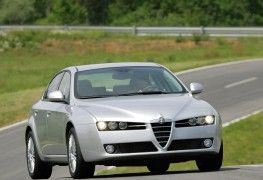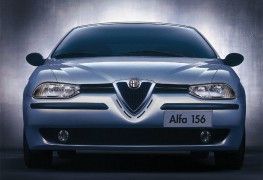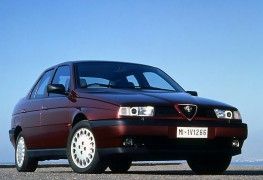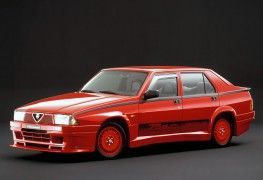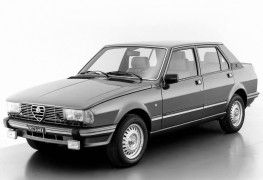The Alfa Romeo 155, despite its sporting successes, did not have the commercial success that the brand expected. With the exception of the Q4 version, the 155 did not have the dynamic performance that Alfa fans expected of it. For this reason, the 155's sporty program was so complete, it was necessary to give the car a certain legitimacy. In any case, it was clear to the brand's management that the 155's replacement had to hit the nail on the head and they started the development of this new model in 1993. In fact, it was so important for the brand that the replacement for the 164 (the 166), also under development at the same time, was stopped when it was almost ready in order to focus on the 932 project (the 156) with which a higher sales volume was expected. Thus the Alfa Romeo 164 was finally presented a year later, when in fact it was a more recent model than the 156.
Recapturing the Alfa Romeo DNA
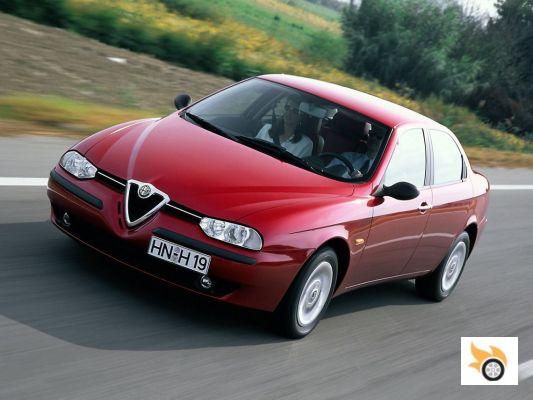 The Alfa Romeo 156 was also an internal revolution for the Arese company. Now under Fiat's control, the first models created under Fiat's tutelage had not convinced. There was nothing Alfa Romeo about the 155, except for some engines. The chassis belonged to the Fiat group and the design to the I.DE.A. institute. There was nothing in the "DNA" of the 155 to present it to the public as a real Alfa Romeo. This was to change with the arrival of Walter de Silva, one of the last important top managers of the brand to be hired before Fiat took over Alfa Romeo.
The Alfa Romeo 156 was also an internal revolution for the Arese company. Now under Fiat's control, the first models created under Fiat's tutelage had not convinced. There was nothing Alfa Romeo about the 155, except for some engines. The chassis belonged to the Fiat group and the design to the I.DE.A. institute. There was nothing in the "DNA" of the 155 to present it to the public as a real Alfa Romeo. This was to change with the arrival of Walter de Silva, one of the last important top managers of the brand to be hired before Fiat took over Alfa Romeo.
In 1993, Alfa Romeo asked Pininfarina (author of the 164), ItalDesign Giugiaro and its own Centro Stile to come up with ideas for the brand's new D-segment saloon. The in-house design centre was gaining strength after the relatively successful launch of the 145 and 146 in the C-segment, these being the first projects supervised by de Silva. In the end, it was the Centro Stile's proposal that won management's favour.
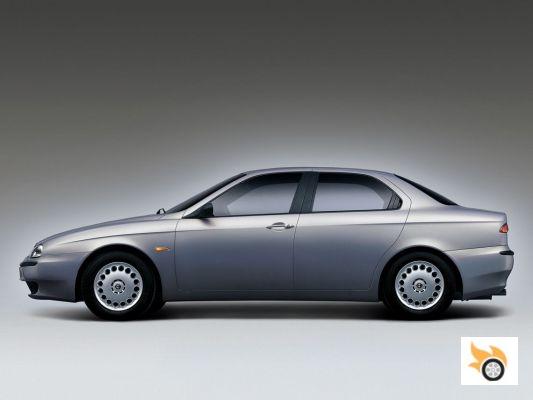
The design team, with Walter de Silva at the helm, consisted of Antonio Rosti as head of design for the 932 project (code 156), while Zbigniew Maurer was in charge of exterior design. Arcangelo Jeker, Giulio Fantin and Vincenzo Ferreri came up with all the interior design, while Simona Falcinella led the colour and materials aspect of the project.
De Silva's team's trump card was to bet on the brand's history. Although the 155 was a faithful example of its era and culture, it was not perceived as an Alfa Romeo, with a "scudetto" on the grille as a last-minute addition. For the 156, the design team took inspiration from the original Giulietta, the Giulia and the 1900.
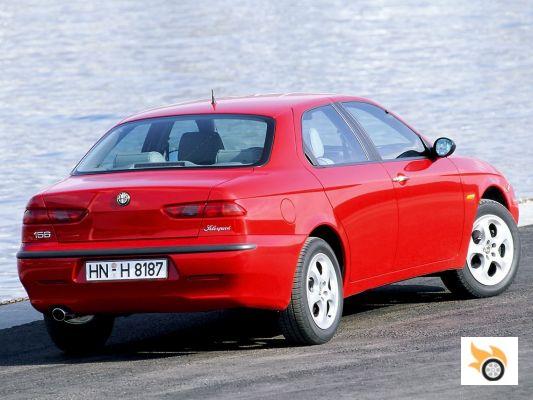 When the public discovered the Alfa Romeo 156 on 11 October at the Frankfurt Motor Show, its rivals suddenly aged a few years (not to mention the 155); compared to a solid Volkswagen Passat (B5) or a slim and elegant Peugeot 406 (designed by Pininfarina), the Alfa Romeo 156 imposed its sporty lines with a certain muscle, an elegant stance, a coupé look and at the same time a huge personality that instantly identified it as an Alfa Romeo.
When the public discovered the Alfa Romeo 156 on 11 October at the Frankfurt Motor Show, its rivals suddenly aged a few years (not to mention the 155); compared to a solid Volkswagen Passat (B5) or a slim and elegant Peugeot 406 (designed by Pininfarina), the Alfa Romeo 156 imposed its sporty lines with a certain muscle, an elegant stance, a coupé look and at the same time a huge personality that instantly identified it as an Alfa Romeo.
The front is dominated by the "scudetto" which, not only bites the front bumper, but seems to determine the whole car. It is as if the lines of the 156 emanate from the "scudetto", Alfa Romeo's symbol par excellence. But this is not the only nod to Alfa Romeo's history. The two lines that form the 156's waistline and delimit the wings are reminiscent of the strong waistline that all Alfa Romeo cars had, from the Giulietta of the 1950s to the 155 (and which we later saw on the 159 and new Giulia, for example). Now the line only emphasizes the wings, as if they were widened) and is interrupted by the handles of the front doors. These are retro-looking and metallic, attracting the eye, while the rear door handles are hidden in the door glass itself, creating the optical illusion of being in front of a classic coupé. Even the proportions between the glass surface and the bodywork, dominated by the body panels, are a nod to the Giulietta.
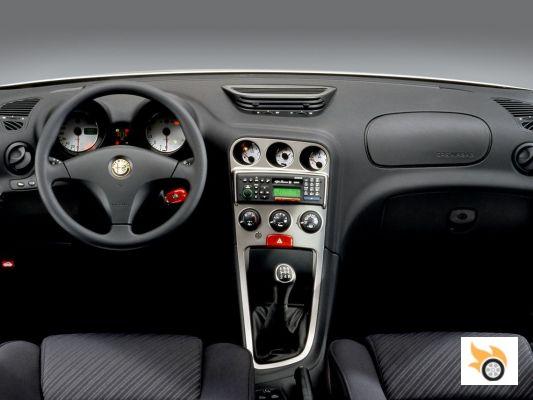
The design team applied the same ideas when creating the interior. Continuing with the tributes to the brand's past and giving it a sporty touch. The instrument panel is simply two clocks, each with its own visor, in the style of Alfa Romeo's most emblematic models, such as the Spider or the Montreal. One is the speedometer and the other the rev counter, while the indicator lights are located between the two main dials. The additional dials (fuel level, temperature and time) are on the top of the centre console. This was also blatantly oriented towards the driver. Optionally, the customer could opt for the steering wheel and gear knob in wood, to give it a retro feel, leather upholstery and even Recaro sports seats. In addition, the 156, which was 13 mm shorter than the 155, offered far greater roominess thanks to a wheelbase that had grown from 2,540 mm in the 155 to 2,600 mm in the 156.
A chassis of its own
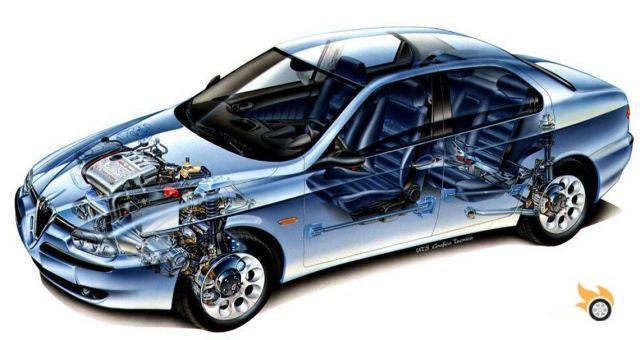
The design of the 156 responds above all to aesthetic criteria, but never neglecting the technical aspect. For example, its Cx value of just 0.31 makes it a very aerodynamic car. Here technique and styling converge by giving the 156 a 62° curved windscreen and a rear end with a 1960s "coda tronca" iare.
The technical aspect is another of the great changes Alfa Romeo made with the 156. The new model was not just a beautiful design object, the brand's engineers worked hard to make the medium saloon from Arese once again the reference in terms of dynamic behaviour, even though it was still a front-wheel drive car.
The importance of the 156 for Alfa Romeo was such that it was decided to equip it with a chassis that was practically unique for it.
The importance of the 156 for Alfa Romeo was such that it was decided to equip it with a chassis that was practically unique to it. The technical basis was the Type II platform, but it was so modified that it ended up being a unique chassis. "We were lucky to have our own chassis. Only the central floor section [in the cabin] is shared with the Fiat Marea, but even that part is modified," explained Antonio Rosti, design director for the 932 project.
The engineers wanted a lighter platform than the Tipo II they were given as a base. Thus, the body structure is in magnesium while higher strength steels were used at strategic points. The suspensions were another point where the 156 differed from the rest of the Fiat group cars.
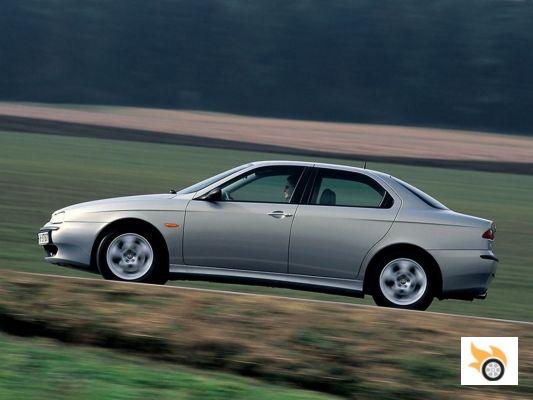 The front axle is of the pseudo McPherson double wishbone type. The upper triangle attached to the control arm prevents the arm from moving longitudinally to limit unwanted torque effects. It combines wide wheel movement with high control of the tyre's working conditions. For the rear suspensions a McPherson strut system was chosen, evolved with asymmetrical arms and a calculated "in-phase" self-directional effect. Part of the Type II Evo 3 platform of the 156 would be inherited by the Alfa Romeo 147 and GT, as well as the Lancia Lybra, but without the 156's suspensions in the case of the Lancia. Thus, the 156 is considered to use its own version of the Type II Evo 3 platform.
The front axle is of the pseudo McPherson double wishbone type. The upper triangle attached to the control arm prevents the arm from moving longitudinally to limit unwanted torque effects. It combines wide wheel movement with high control of the tyre's working conditions. For the rear suspensions a McPherson strut system was chosen, evolved with asymmetrical arms and a calculated "in-phase" self-directional effect. Part of the Type II Evo 3 platform of the 156 would be inherited by the Alfa Romeo 147 and GT, as well as the Lancia Lybra, but without the 156's suspensions in the case of the Lancia. Thus, the 156 is considered to use its own version of the Type II Evo 3 platform.
Genuine Alfa Romeo dynamism
In driving, the elaborate suspensions with a very stiff structure work wonders. The result is a precision and immediacy of response to the steering wheel (with very direct and precise steering) coupled with overwhelming stability and ease of control. This agility and at the same time stability and ease of control - because of its noble chassis and because the car "talks to you" - are the essential characteristics of a sports car that gives you driving pleasure.
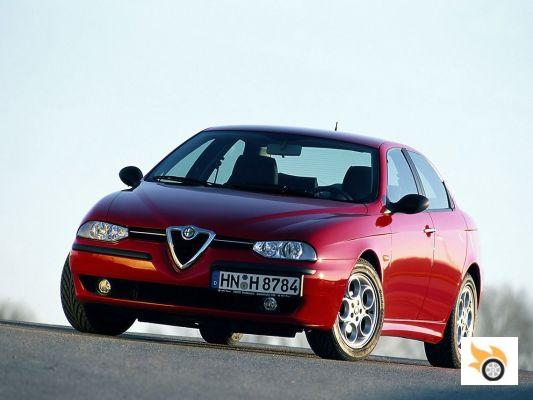 In 1997, the 156 arrives with a range of 4 petrol engines (all with 4-valve cylinder head) and 2 turbodiesels. In petrol, the 4-cylinder 1.6 Twin Spark 120 hp was already present in the 155 during its last year of marketing and returns for the 156. It should be noted that there was a 112 hp version, for tax reasons, for the French market. The 1.8 TS and 2.0 TS were also part of the 155 range, but for the 156 they have a variable intake and gain 5 bhp in maximum power, 144 bhp and 155 bhp, respectively. At the top of the range was the new 190bhp 2.5-litre 24-valve V6.
In 1997, the 156 arrives with a range of 4 petrol engines (all with 4-valve cylinder head) and 2 turbodiesels. In petrol, the 4-cylinder 1.6 Twin Spark 120 hp was already present in the 155 during its last year of marketing and returns for the 156. It should be noted that there was a 112 hp version, for tax reasons, for the French market. The 1.8 TS and 2.0 TS were also part of the 155 range, but for the 156 they have a variable intake and gain 5 bhp in maximum power, 144 bhp and 155 bhp, respectively. At the top of the range was the new 190bhp 2.5-litre 24-valve V6.
Together with the Mercedes C220 CDI of the same year, the diesel engines inaugurate common-rail direct injection.
While the petrol range is familiar, the diesel range is new. The two engines that make it up are new and inaugurate - along with the Mercedes C220 CDI of the same year - the common-rail direct injection. Like direct injection for diesels, common rail injection is a FIAT invention developed by Bosch. The two engines are the 105 hp 4-cylinder 1.9 JTD and the 136 hp 5-cylinder 2.4 JTD (2,387 cc). Throughout the 156's commercial life, 51% of customers opted for the JTD engines.
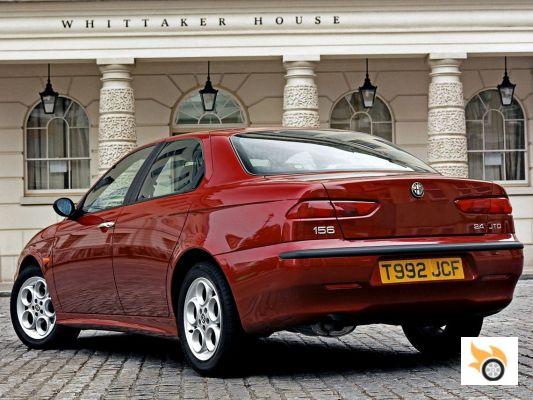 The transmissions available at launch consisted of a 5-speed manual gearbox for the 1.6 TS and a 6-speed for the other engines. The 2.0 TS could be fitted with the optional Selespeed robotised gearbox, while the V6 could be fitted with a classic Aisin Q-System 4-speed automatic transmission.
The transmissions available at launch consisted of a 5-speed manual gearbox for the 1.6 TS and a 6-speed for the other engines. The 2.0 TS could be fitted with the optional Selespeed robotised gearbox, while the V6 could be fitted with a classic Aisin Q-System 4-speed automatic transmission.
156 Sportwagon
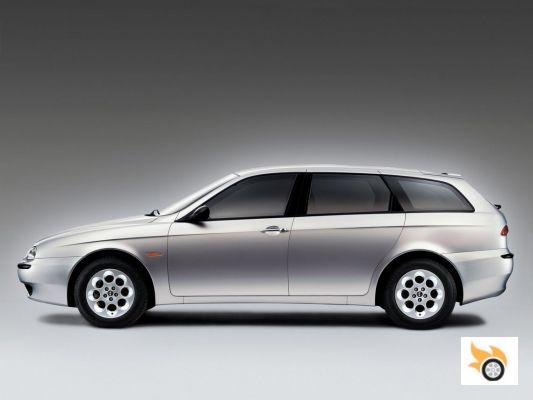 From the very beginning of the 156 project, a family variant was considered, but they didn't want to propose a simple family version of the 156. They thought of this body as a different model simply related to the 156. The team led by de Silva simply created a shooting brake on the basis of the 156 and its coupé look.
From the very beginning of the 156 project, a family variant was considered, but they didn't want to propose a simple family version of the 156. They thought of this body as a different model simply related to the 156. The team led by de Silva simply created a shooting brake on the basis of the 156 and its coupé look.
The body retained its sporty look, with the same features and nods to Alfa Romeo's past. The rear lights are the same, as are the dimensions of the car: Alfa Romeo did not want to stretch the rear overhang as all manufacturers do and it is identical to that of the saloon. The roof slopes slightly towards the rear window and ends in a small integrated spoiler. The result is a model with an undoubtedly sporty character. Hence, they chose to call it Sportwagon.
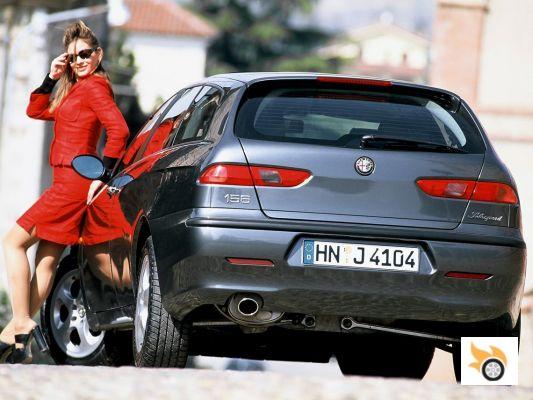 Alfa Romeo did not want the 156 to be a car for transporting work tools, that era of the "break for everything" had been left behind, and positioned the Sportwagon as a car associated with a dynamic and family lifestyle. In fact, the boot capacity (from 360 to 1,180 litres) was nothing exceptional compared to its rivals, but the 156 Sportwagon's clientele didn't want a cargo truck, but a family car that was also sporty. And Alfa Romeo gave it to them, as the 156 Sportwagon retained all the qualities of the 156 saloon, allowing itself the luxury of being even more aerodynamic with its 0.30 Cx.
Alfa Romeo did not want the 156 to be a car for transporting work tools, that era of the "break for everything" had been left behind, and positioned the Sportwagon as a car associated with a dynamic and family lifestyle. In fact, the boot capacity (from 360 to 1,180 litres) was nothing exceptional compared to its rivals, but the 156 Sportwagon's clientele didn't want a cargo truck, but a family car that was also sporty. And Alfa Romeo gave it to them, as the 156 Sportwagon retained all the qualities of the 156 saloon, allowing itself the luxury of being even more aerodynamic with its 0.30 Cx.
"Nuova 156?"
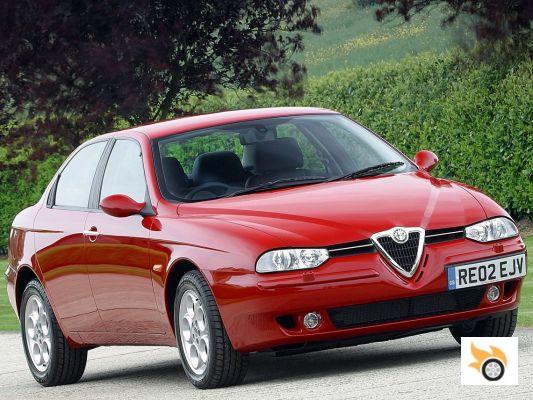 The first update of the Alfa Romeo 156 arrived at the end of 2001, being the 2002 model year. For once we must speak exclusively of an update and not a restyling or facelift. Alfa Romeo's managers did not dare to touch the car's design. The only aesthetic differences with respect to the 156 of the first series are so minimal that they go unnoticed. The bumper mouldings, as well as the fog lamp surrounds and door mirrors are now body-coloured.
The first update of the Alfa Romeo 156 arrived at the end of 2001, being the 2002 model year. For once we must speak exclusively of an update and not a restyling or facelift. Alfa Romeo's managers did not dare to touch the car's design. The only aesthetic differences with respect to the 156 of the first series are so minimal that they go unnoticed. The bumper mouldings, as well as the fog lamp surrounds and door mirrors are now body-coloured.
The changes in the cabin are a little more obvious. There is a new multifunction steering wheel. The centre console is slightly redesigned and there is a small screen for the on-board computer, or the optional navigator, high up on the dashboard. In addition, dual-zone climate control has become standard in almost all markets. Both inside and out, the changes are anecdotal, but mechanically the changes are more significant.
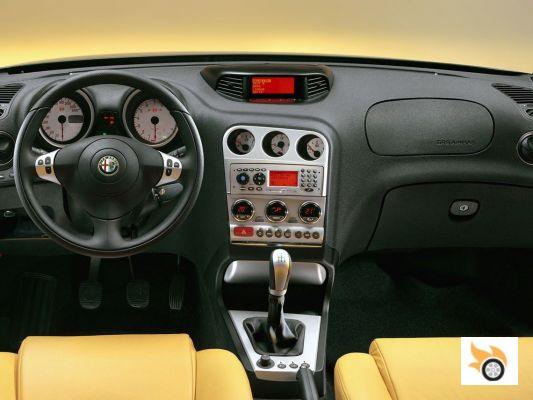 The 1.9 JTD gets a 16-valve cylinder head that delivers 140 bhp (116 bhp for the 1.9 JTD 8V) and 305 Nm of torque. It is called the 1.9 JTDm. The 5-cylinder diesel 2.4 JTD goes from 140 hp to 150 hp thanks to a new ECU while slightly lowering its average homologated fuel consumption. But the biggest change was made to the 2.0 litre. Alfa Romeo abandons the 2.0 Twin Spark in favour of the 2.0 JTS (for Jet Thrust Stoichiometric) with direct petrol injection. This 2.0 JTS would be the first of a long series of such engines at Alfa Romeo.
The 1.9 JTD gets a 16-valve cylinder head that delivers 140 bhp (116 bhp for the 1.9 JTD 8V) and 305 Nm of torque. It is called the 1.9 JTDm. The 5-cylinder diesel 2.4 JTD goes from 140 hp to 150 hp thanks to a new ECU while slightly lowering its average homologated fuel consumption. But the biggest change was made to the 2.0 litre. Alfa Romeo abandons the 2.0 Twin Spark in favour of the 2.0 JTS (for Jet Thrust Stoichiometric) with direct petrol injection. This 2.0 JTS would be the first of a long series of such engines at Alfa Romeo.
Alfa Romeo opted for the 2.0 JTS to improve performance. With this injection system, quick response and better performance (greater cylinder filling, possibility of increasing compression from 10.31:1 to 11.3:1) are obtained at the top end of the engine and under heavy loads, while keeping the stoichiometric ratio of the air-petrol mixture constant (14.7:1). Conversely, it reserves the injection with stratified or lean mixture (25:1) in the low range and at around 1,500 rpm in order to reduce average fuel consumption.
Alfa Romeo 156 GTA
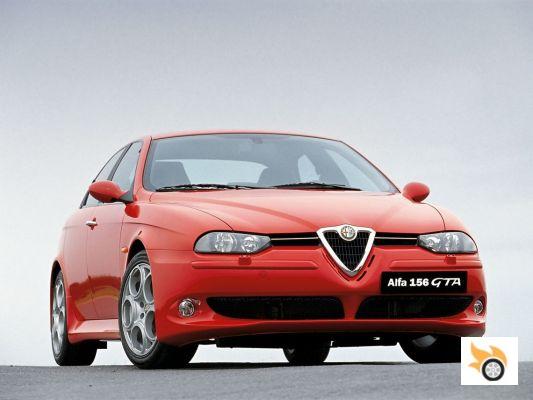 At the end of 2001, Alfa Romeo had already dominated several touring car championships for 4 years and had just won the European title. And all this with the 156 GTA racing car. For regulatory reasons it is powered by the 2.0-litre Twin Spark with 270 hp. Even so, the 156 range does not have a sporty version in which the brand's sporting success can be appreciated. The engineers in the competition department said that the 156's base had "given them several aces up their sleeves". The aerodynamics of the model was one of them, but "the design of the suspension, particularly suited to sporty driving, and the extreme rigidity of the monocoque", they said, were other important aces. In November of the same year, taking advantage of the very slight restyling of the model, the 156 range finally received this version. The 156 GTA arrives and is available in sedan and Sportwagon body styles.
At the end of 2001, Alfa Romeo had already dominated several touring car championships for 4 years and had just won the European title. And all this with the 156 GTA racing car. For regulatory reasons it is powered by the 2.0-litre Twin Spark with 270 hp. Even so, the 156 range does not have a sporty version in which the brand's sporting success can be appreciated. The engineers in the competition department said that the 156's base had "given them several aces up their sleeves". The aerodynamics of the model was one of them, but "the design of the suspension, particularly suited to sporty driving, and the extreme rigidity of the monocoque", they said, were other important aces. In November of the same year, taking advantage of the very slight restyling of the model, the 156 range finally received this version. The 156 GTA arrives and is available in sedan and Sportwagon body styles.
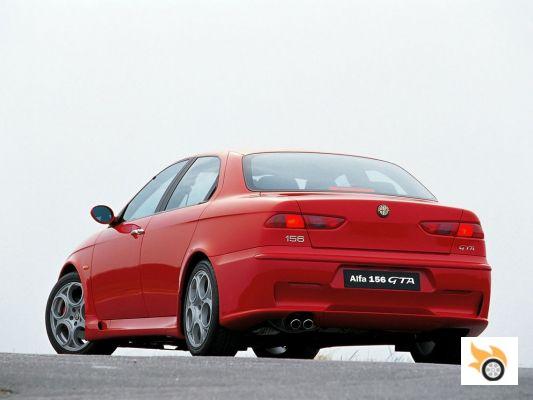 The acronym GTA obviously refers to the Giulia Sprint GTA (1965-1969). However, there is nothing "allegerata" about the 156 GTA. There is nothing about it that makes it lighter than a normal 156; quite the opposite. Under the bonnet is not a 2.0 TS but a V6. It's the same 60° V-block as the 156 2.5 V6 (the basis of which can be traced back to the 1979 Alfa 6 block designed by Giuseppe Busso), but uprated to 3,179 cc by increasing the stroke and bore of the cylinders (88×66.3 mm in the 2.5 to 93×78 mm in the 3.2). With a power output of 250 hp at 6,200 rpm and 300 Nm at 4,800 rpm, the 156 GTA is worthy of the acronym GTA despite its 1,410 kg (when a 2.0 TS did not reach 1,300 kg). It does 0-60 mph in 6.3 seconds and reaches a top speed of 250 mph.
The acronym GTA obviously refers to the Giulia Sprint GTA (1965-1969). However, there is nothing "allegerata" about the 156 GTA. There is nothing about it that makes it lighter than a normal 156; quite the opposite. Under the bonnet is not a 2.0 TS but a V6. It's the same 60° V-block as the 156 2.5 V6 (the basis of which can be traced back to the 1979 Alfa 6 block designed by Giuseppe Busso), but uprated to 3,179 cc by increasing the stroke and bore of the cylinders (88×66.3 mm in the 2.5 to 93×78 mm in the 3.2). With a power output of 250 hp at 6,200 rpm and 300 Nm at 4,800 rpm, the 156 GTA is worthy of the acronym GTA despite its 1,410 kg (when a 2.0 TS did not reach 1,300 kg). It does 0-60 mph in 6.3 seconds and reaches a top speed of 250 mph.
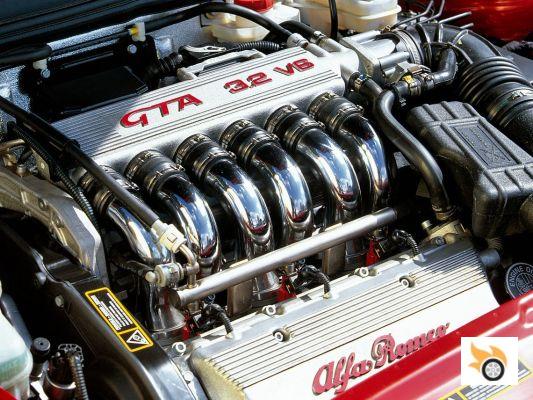 The V6 was paired with a 6-speed manual gearbox. Optionally, the GTA could be fitted with a Selespeed robotised gearbox, which over time proved to be somewhat fragile. The suspension and brakes, especially those of the 2003 model year, were also adapted to the high performance of the new model.
The V6 was paired with a 6-speed manual gearbox. Optionally, the GTA could be fitted with a Selespeed robotised gearbox, which over time proved to be somewhat fragile. The suspension and brakes, especially those of the 2003 model year, were also adapted to the high performance of the new model.
The body kit (and wheels) that set it apart from the other 156s was both aggressive and elegant, while its dynamic behaviour made it the best front-wheel drive car of the time. Even so, the front end was not free from torque drag.
In the end, the 156 GTA remained in production until 2005 without receiving the aesthetic changes that the rest of the range would undergo in 2003. Even so, just 4,651 units were produced. Of which 2,625 units were manual saloon cars and 348 with Selespeed gearbox, while there were 1,174 GTA Sportwagons with manual gearbox and 504 units with Selespeed gearbox.
Restyling
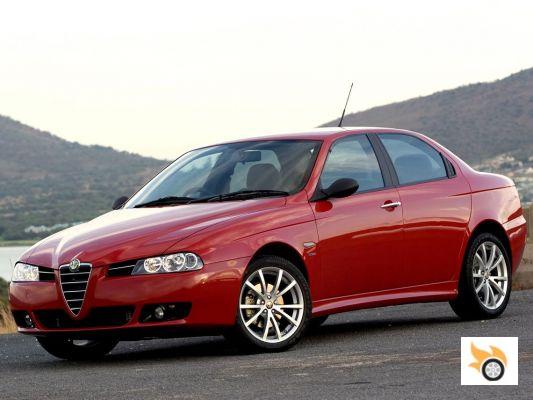 In July 2003, the 156 was almost six years old. For many models, after six years, it's time for them to go out of production. The 156, on the other hand, had its first and only restyling. In the meantime, Walter de Silva accepted the VAG Group's offer and went to Spain to revitalize SEAT's design. It is not clear if it was a direct consequence, but without de Silva at the head of the Centro Stile, the restyling of the 156 fell into the hands of Guigiaro. Guigiaro had already started designing the 159 (the 156's replacement) and this was evident in the styling direction of the new 156's front end.
In July 2003, the 156 was almost six years old. For many models, after six years, it's time for them to go out of production. The 156, on the other hand, had its first and only restyling. In the meantime, Walter de Silva accepted the VAG Group's offer and went to Spain to revitalize SEAT's design. It is not clear if it was a direct consequence, but without de Silva at the head of the Centro Stile, the restyling of the 156 fell into the hands of Guigiaro. Guigiaro had already started designing the 159 (the 156's replacement) and this was evident in the styling direction of the new 156's front end.
The "scudetto" is now larger, as are the two air intakes flanking it, while the headlights give the car an aggressive look. The boot lid, with its two horizontal bodywork folds, seems to give the drivers eyebrows. Obviously, the bumpers are new. Even so, the silhouette of the 156 remains unchanged and the car is still a commercial success.
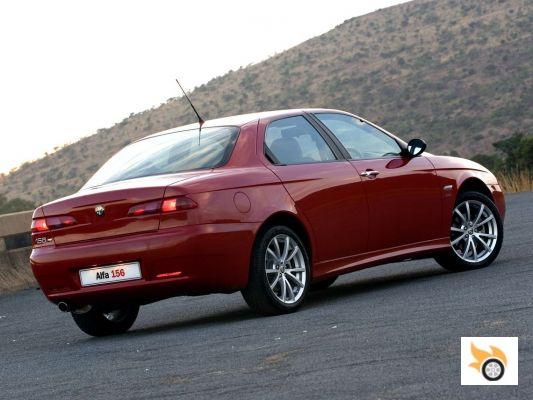 Mechanically, the changes focus on the diesel engines. The 1.9 JTDm now produces 150 bhp, while the 5-cylinder 2.4 JTD now has a 16-valve cylinder head. Its power output then rises to 170 bhp and delivers 385 Nm at 2,000 rpm.
Mechanically, the changes focus on the diesel engines. The 1.9 JTDm now produces 150 bhp, while the 5-cylinder 2.4 JTD now has a 16-valve cylinder head. Its power output then rises to 170 bhp and delivers 385 Nm at 2,000 rpm.
The range, meanwhile, retains the 156 GTA with the old bodywork and arrives with a new finish, the TI. The idea was to offer a somewhat sporty version for those who couldn't or didn't want the exuberant GTA. It was equipped with sports suspension, 17-inch alloy wheels specific to the TI, and black leather upholstery with red contrast stitching. It was available in both petrol and diesel.
Alfa Romeo 156 Crosswagon Q4
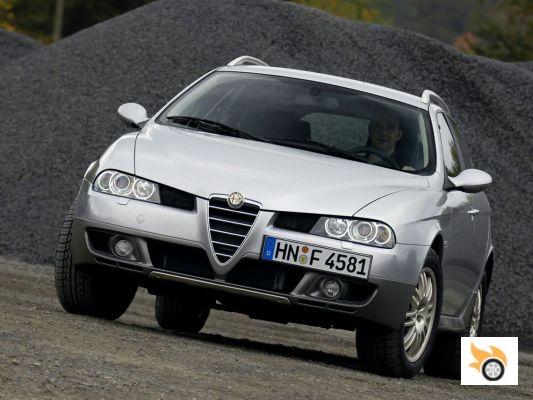 Curiously, in June 2004, less than a year before the 159 was launched (March 2005), Alfa Romeo launched a new version of the 156 based on the Sportwagon (which could now be optioned with all-wheel drive), the Crosswagon Q4. Seeing the success of the premium SUVs - raised roofs with a 4×4 look - such as the Audi A6 Allroad or the Volvo XC70, Alfa Romeo launches its SUV proposal to the market. The idea was to take advantage of the boom in this type of vehicle and above all to prepare the public for the arrival of Alfa Romeo's SUV, the Kamal. Which, in the end, would never arrive.
Curiously, in June 2004, less than a year before the 159 was launched (March 2005), Alfa Romeo launched a new version of the 156 based on the Sportwagon (which could now be optioned with all-wheel drive), the Crosswagon Q4. Seeing the success of the premium SUVs - raised roofs with a 4×4 look - such as the Audi A6 Allroad or the Volvo XC70, Alfa Romeo launches its SUV proposal to the market. The idea was to take advantage of the boom in this type of vehicle and above all to prepare the public for the arrival of Alfa Romeo's SUV, the Kamal. Which, in the end, would never arrive.
It was only available with the 1.9 litre 150 bhp JTDm turbodiesel engine and 6-speed manual gearbox. Alfa Romeo offered it with two types of traction: front-wheel drive and Q4 Torsen-type all-wheel drive (which gave priority to the rear axle on dry asphalt).
When it was launched on the market, I was already testing cars and I remember that despite its adventurous aesthetics, the 156 Crosswagon offered very good traction on slippery terrain and that on tarmac it retained almost all the dynamism of the Sportwagon despite its 20 cm of headroom (+65 mm compared to a normal 156).
The 156 Crosswagen remained in production for three years, as it continued in the range alongside the 159 as a sui generis model. Alfa Romeo eventually produced 7,032 units of the Crosswagon Q4.
The 156's successor, the 159, was unveiled at the 2005 Geneva Motor Show marking the end of the 156's career. The last 156 saloon left the factory in 2005, while the Crosswagon Q4 ceased production in 2007. Over its 10-year sales career, 651,156 units were produced. The 156 has been one of the brand's most commercially successful models. It was also one of the most critically and publicly acclaimed. Its influence is still with Alfa Romeo today. So much so that its design and sporty dynamic performance have served as inspiration for the creation of the new Giulia that we will see on the road in 2016.
The return of Alfa Romeo: from the 1900 to the Giulia